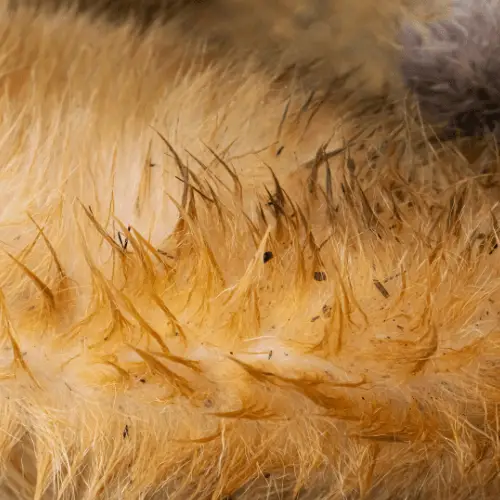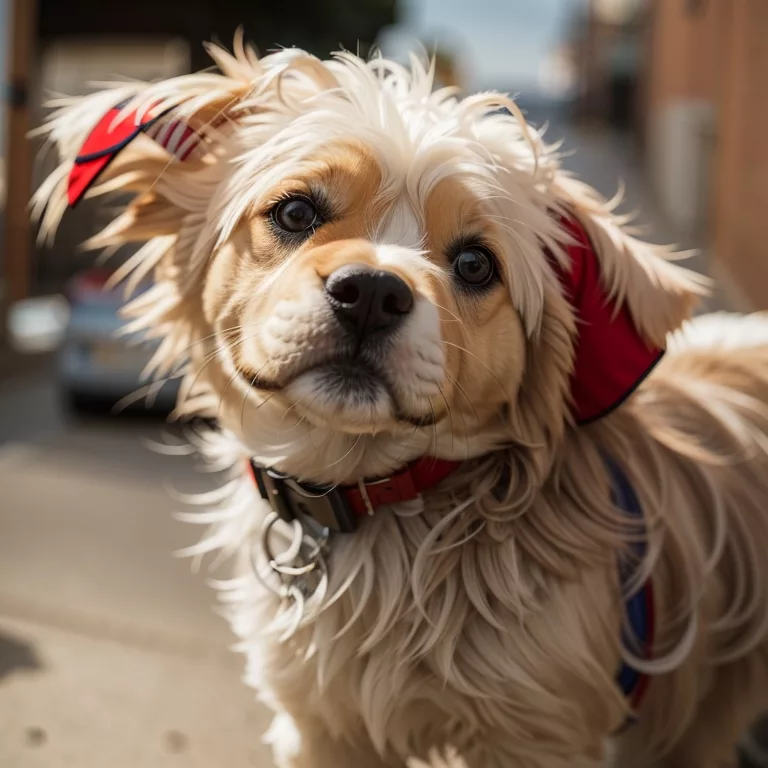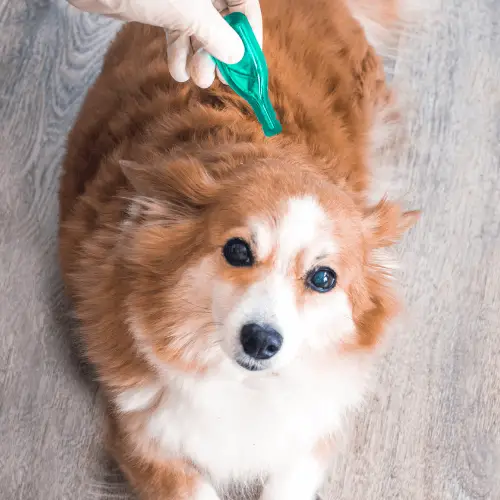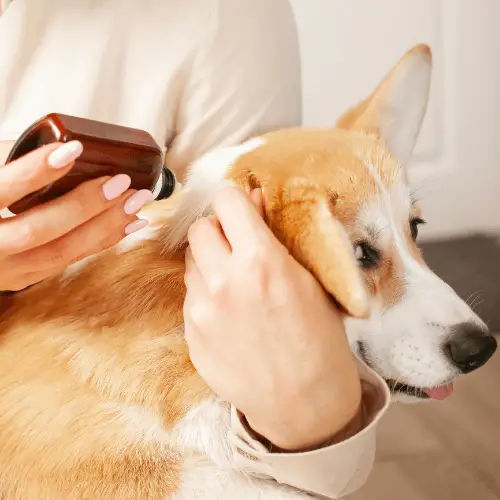What Does Flea Dirt Look Like on a Dog?

As a dog owner, I know how important it is to keep our furry friends healthy and happy. One common issue that many dog owners face is the presence of flea dirt on their dogs. Flea dirt is the feces of adult fleas and can be an indicator of a larger flea infestation. In this article, we will explore what flea dirt looks like, how to identify it on your dog, and the significance of addressing this issue for the well-being of your canine companion. So, let’s dive into the world of flea dirt and learn how to keep our dogs flea-free and comfortable.

What is Flea Dirt?
Flea dirt is the feces of adult fleas, which originates from the fleas feeding on your dog’s blood. These feces are composed of digested blood, giving them a dark red or black appearance. Flea dirt can be found on your dog’s skin and fur, often appearing as tiny, dark specks. These specks may resemble ground pepper, tiny black dots, or even dark-colored dandruff.
When you find flea dirt on your dog, it’s an indication that your pet has fleas. It’s essential to address this issue to ensure the health and comfort of your canine companion. In the following sections, we will discuss how to identify flea dirt, its connection to flea infestations, and the necessary steps to take to protect your dog from fleas.
Identifying Flea Dirt on Your Dog
Spotting flea dirt on your dog can be a crucial step in addressing a potential flea infestation. To identify flea dirt, look for tiny, dark specks on your dog’s skin and fur. These specks may resemble ground pepper, tiny black dots, or even dark-colored dandruff. Flea dirt is often found in areas where fleas are most concentrated, such as around the base of the tail, the lower back, and the backs of the hind legs.
It’s essential to differentiate between flea dirt and regular dirt or dandruff. While flea dirt is composed of digested blood, giving it a dark red or black appearance, regular dirt is simply soil or debris from the environment. Dandruff, on the other hand, consists of thin, light, irregular-shaped flakes of skin.

To determine if the specks you see are flea dirt, you can perform a simple test. Flick some of the specks onto a damp white cloth or piece of paper. If the specks leave a reddish-brown stain, it’s likely flea dirt, as the color comes from the digested blood. Regular dirt will not leave a reddish stain, and dandruff will maintain its light color and flaky appearance.
By accurately identifying flea dirt on your dog, you can take the necessary steps to address a potential flea infestation and ensure the health and comfort of your canine companion.
The Connection Between Flea Dirt and Flea Infestations

Flea Life Cycle and Flea Dirt as an Indicator of Infestation
Fleas have a four-stage life cycle: egg, larva, pupa, and adult. Adult fleas lay eggs in the fur and surroundings of their host, which hatch into larvae within one to ten days. The larvae feed on blood and flea feces, also known as “flea dirt,” to continue their development. After 5-20 days of feeding on flea dirt, the larvae spin a cocoon and enter the pupa stage. Adult fleas emerge from the cocoon when they detect the presence of a host, such as movement or body heat, signaling that a blood meal is available.
Flea dirt is pre-digested blood passed by adult fleas. It serves as a food source for flea larvae and is a clear indicator of a flea infestation. The presence of flea dirt on your pet or in their environment suggests that adult fleas are present and reproducing.
Risks Associated with Flea Infestations
Flea infestations pose several risks to both pets and humans. For pets, fleas can cause flea allergy dermatitis, which is an allergic reaction to flea saliva, leading to skin irritation and discomfort. Fleas can also transmit tapeworms to pets if they ingest an infected flea. In severe cases, flea infestations can cause anemia, especially in young or small animals, which can lead to severe illness and even death.

For humans, fleas can transmit diseases such as plague, murine typhus, and cat-scratch fever. Flea bites can also cause allergic reactions and secondary infections due to scratching. Although fleas do not live on humans, they can still bite and cause health issues.
To prevent and control flea infestations, it is essential to treat both the environment and the pets living in it. Regular vacuuming, washing pet bedding and toys, and using appropriate flea treatments for pets can help eliminate fleas and prevent future infestations.
Health Risks for Dogs and Humans
Potential Health Risks for Dogs
Flea infestations can lead to several health issues for dogs. One common problem is flea allergy dermatitis, an allergic reaction to flea saliva that causes skin irritation and discomfort. In some cases, flea infestations can also lead to anemia, especially in young or small dogs. Anemia occurs when fleas feed on a dog’s blood, depleting their red blood cell count. If left untreated, anemia can result in severe illness and even death. Another health risk associated with fleas is the transmission of tapeworms. If a dog ingests an infected flea while grooming, they can become infected with tapeworms, which can rob them of vital nutrients.
Potential Health Risks for Humans
While fleas primarily infest animals, they can still bite and cause health issues for humans. Flea bites can trigger allergic reactions and secondary infections due to scratching. In some cases, fleas can transmit diseases such as plague, murine typhus, and cat-scratch fever. Although fleas do not live on humans, their presence in the home can still pose a significant health risk. To protect both pets and humans, it is essential to address flea infestations promptly and take preventive measures to keep fleas at bay.

Preventing Flea Dirt and Flea Infestations
List preventive measures for flea infestations, such as regular grooming and flea treatments
- Regular grooming: Brush your pet’s fur and use a flea comb to check for fleas. Grooming helps remove flea dirt and can help detect fleas early.
- Flea treatments: Use flea collars, topical applications, or oral medications to prevent fleas on your pet. Consult your veterinarian for the best option for your pet.
- Bathe your pet regularly: Washing your pet with a flea shampoo can help remove fleas and flea dirt.
- Keep your pet’s environment clean: Wash pet bedding, blankets, and toys in hot soapy water regularly.
- Vacuum your home frequently: Vacuum carpets, rugs, cushions on chairs and sofas, and dispose of the vacuum bag outside when finished.
- Maintain a clean yard: Mow your lawn regularly and trim shrubs to reduce hiding places for fleas.
- Limit your pet’s contact with wild and stray animals: This can help reduce the chances of your pet picking up fleas from other animals.
Discuss the importance of maintaining a clean environment for your dog
Maintaining a clean environment for your dog is crucial in preventing flea infestations. Fleas can live in carpets, bedding, and other surfaces where pets frequent. By keeping your pet’s environment clean, you can help prevent an infestation from taking hold and spreading throughout your home. Regular cleaning, vacuuming, and washing of pet bedding and other items can help remove flea dirt, eggs, and adult fleas, reducing the chances of an infestation. Additionally, a clean environment can help keep your pet healthy and comfortable, reducing the risk of skin irritations and infections caused by flea bites.
What to Do If You Find Flea Dirt on Your Dog
Steps to Take If You Discover Flea Dirt on Your Dog

If you find flea dirt on your dog, it’s essential to take action to address the potential flea infestation. Here are some steps you can take:
- Confirm the presence of fleas: Perform a thorough inspection of your dog’s fur and skin to look for adult fleas or additional flea dirt. Use a flea comb to help with this process.
- Choose a flea treatment: Select an appropriate flea treatment for your dog, such as topical applications, oral medications, or flea collars. Consult your veterinarian for recommendations based on your dog’s specific needs.
- Treat your dog: Administer the chosen flea treatment according to the product’s instructions and your veterinarian’s guidance.
- Clean your dog’s environment: Wash your dog’s bedding, toys, and other belongings in hot, soapy water. Vacuum your home thoroughly, focusing on areas where your dog spends the most time.
- Monitor your dog: Keep an eye on your dog for any signs of continued flea infestation or potential side effects from the flea treatment. If you notice any issues, consult your veterinarian for further guidance.
Importance of Consulting a Veterinarian for Proper Guidance
Consulting a veterinarian is crucial when dealing with flea dirt and potential infestations. Your vet can help you determine the best course of action for your specific situation, taking into account your dog’s age, size, breed, and overall health. They can also recommend the most effective flea treatments and provide guidance on how to administer them safely. Additionally, your veterinarian can help you identify any underlying health issues that may be contributing to your dog’s susceptibility to fleas, such as allergies or skin conditions. By working closely with your vet, you can ensure the health and well-being of your canine companion.
Cleaning Your Home to Eliminate Flea Dirt and Fleas
Tips for Cleaning Your Home to Remove Flea Dirt and Prevent Future Infestations
To effectively clean your home and eliminate flea dirt and fleas, follow these tips:
- Wash pet bedding in hot water: Regularly wash your pet’s bedding, blankets, and toys in hot soapy water to remove flea dirt, eggs, and adult fleas.
- Vacuum carpets, rugs, and furniture regularly: Vacuum your home thoroughly, including under furniture and in hard-to-reach areas, to remove fleas and their eggs from carpets, furniture, and other surfaces.
- Steam clean: Use a steam cleaner on carpets, upholstery, and pet beds to kill fleas at all stages of their life cycle.
- Maintain a clean yard: Mow your lawn regularly and trim shrubs to reduce hiding places for fleas.
- Keep your home tidy: Cluttered spaces provide more hiding spots for fleas, so maintain a clean and organized home.
Importance of Washing Your Dog’s Bedding and Belongings
Washing your dog’s bedding and belongings is crucial in preventing flea infestations. Fleas can live in bedding, toys, and other surfaces where pets frequent. By washing these items regularly, you can help remove flea dirt, eggs, and adult fleas, reducing the chances of an infestation. Additionally, maintaining a clean environment for your dog can help keep them healthy and comfortable, reducing the risk of skin irritations and infections caused by flea bites.
Monitoring Your Dog for Flea Dirt and Flea Infestations
How Often to Check Your Dog for Flea Dirt
It’s essential to monitor your dog regularly for flea dirt and potential infestations. Ideally, you should check your dog for flea dirt at least once a month. However, if your dog is prone to flea infestations or has had issues in the past, you may want to check more frequently, such as once a week. Regular inspections can help you catch flea infestations early and take action to prevent them from becoming more severe.
Signs of a More Severe Flea Problem
If you notice any of the following signs, your dog may be experiencing a more severe flea problem:
- Excessive scratching, biting, or licking: If your dog is constantly scratching, biting, or licking their skin, it may be a sign of a flea infestation causing discomfort.
- Hair loss: Hair loss, especially in patches, can be a sign of flea allergy dermatitis or excessive scratching due to flea bites.
- Red, irritated skin: Inflamed or irritated skin can be a sign of flea allergy dermatitis or a secondary infection caused by scratching.
- Visible fleas: If you see adult fleas on your dog or in their environment, it’s a clear sign of an infestation.
- Pale gums: Pale gums can be an indicator of anemia, which can result from a severe flea infestation depleting your dog’s red blood cell count.
If you suspect your dog has a severe flea problem, consult your veterinarian for guidance on the best course of action to protect your pet’s health and well-being.
Conclusion
In this article, we’ve explored the topic of flea dirt and its significance for dog owners. We’ve learned that flea dirt is the feces of adult fleas and serves as an indicator of a flea infestation. We’ve discussed how to identify flea dirt on your dog and the importance of differentiating it from regular dirt or dandruff.
We’ve also examined the connection between flea dirt and flea infestations, as well as the potential health risks for both dogs and humans. Preventive measures, such as regular grooming, flea treatments, and maintaining a clean environment, are crucial in keeping flea infestations at bay.
If you find flea dirt on your dog, it’s essential to take action by treating your pet and cleaning their environment. Regularly monitoring your dog for flea dirt and signs of a more severe flea problem can help ensure their health and well-being.
As a responsible dog owner, it’s up to you to protect your canine companion from flea dirt and infestations. By staying vigilant and taking the necessary steps to prevent and address flea issues, you can help keep your dog healthy, comfortable, and flea-free.
I apologize for the confusion. Here is a FAQ based on the 20 questions you provided earlier in the conversation:
Frequently Asked Questions
1. What is flea dirt? Flea dirt is the feces of adult fleas, which appears as tiny, dark red-to-black specks on a dog’s skin and fur.
2. How can I identify flea dirt on my dog? Look for tiny, dark specks on your dog’s skin and fur, often resembling ground pepper or dark-colored dandruff.
3. What does flea dirt look like? Flea dirt appears as tiny, dark red-to-black specks on a dog’s skin and fur.
4. How can I tell the difference between flea dirt and regular dirt? Flick some of the specks onto a damp white cloth or piece of paper. If the specks leave a reddish-brown stain, it’s likely flea dirt, as the color comes from the digested blood.
5. Can flea dirt harm humans? Flea dirt itself is not harmful to humans, but fleas can transmit diseases and cause allergic reactions from their bites.
6. What are the risks associated with finding flea dirt on my pet? Flea dirt indicates the presence of fleas, which can cause skin irritation, allergies, anemia, and transmit diseases to both pets and humans.
7. How can I prevent flea dirt and fleas on my dog? Preventive measures include regular grooming, flea treatments, bathing your pet regularly, and maintaining a clean environment for your dog.
8. What should I do if I find flea dirt on my dog? Consult your veterinarian for guidance on the best course of action, which may include flea treatments and cleaning your pet’s environment.
9. Can flea dirt cause anemia in dogs? Flea infestations can cause anemia in dogs, especially in young or small animals, due to the fleas feeding on the dog’s blood.
10. How can I remove flea dirt from my dog’s fur? Regular grooming, using a flea comb, and bathing your dog with a flea shampoo can help remove flea dirt from their fur.
11. Can flea dirt be found in my dog’s bedding? Yes, flea dirt can be found in your dog’s bedding, as well as other surfaces where pets frequent.
12. How can I tell if my dog has fleas or just flea dirt? Inspect your dog’s fur and skin for adult fleas or additional flea dirt. Use a flea comb to help with this process.
13. What is the connection between flea dirt and the flea life cycle? Flea dirt is pre-digested blood passed by adult fleas and serves as a food source for flea larvae, indicating the presence of an infestation.
14. Can flea dirt cause skin irritation or allergies in dogs? Flea dirt itself does not cause skin irritation or allergies, but the fleas that produce the dirt can cause flea allergy dermatitis in dogs.
15. How can I prevent flea infestations in my home? Regular vacuuming, washing pet bedding and toys, and using appropriate flea treatments for pets can help eliminate fleas and prevent future infestations.
16. Can flea dirt be a sign of a more severe flea problem? Yes, the presence of flea dirt on your pet or in their environment suggests that adult fleas are present and reproducing.
17. How can I clean my home to get rid of flea dirt and fleas? Wash pet bedding, vacuum carpets and furniture, steam clean surfaces, and maintain a clean yard to help eliminate flea dirt and fleas.
18. Can flea dirt cause diseases in dogs or humans? Flea dirt itself does not cause diseases, but fleas can transmit diseases to both dogs and humans.
19. How often should I check my dog for flea dirt? Ideally, you should check your dog for flea dirt at least once a month, or more frequently if your dog is prone to flea infestations.
20. What is the best way to treat my dog if I find flea dirt on them? Consult your veterinarian for guidance on the best course of action, which may include flea treatments and cleaning your pet’s environment.
Hi, I’m John and I love dogs. Ever since I was a kid, I always wanted to have a furry friend by my side. I grew up with a golden retriever named Max, who taught me a lot about loyalty, friendship, and fun. He was my best buddy for 12 years, and I miss him every day.
